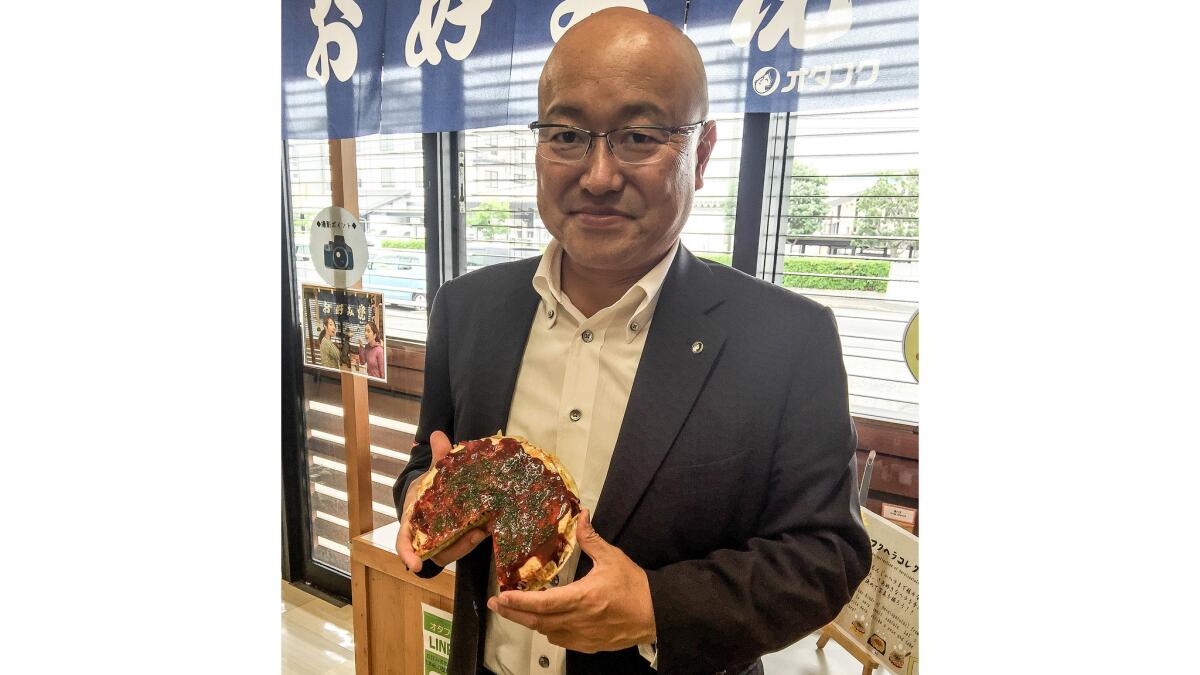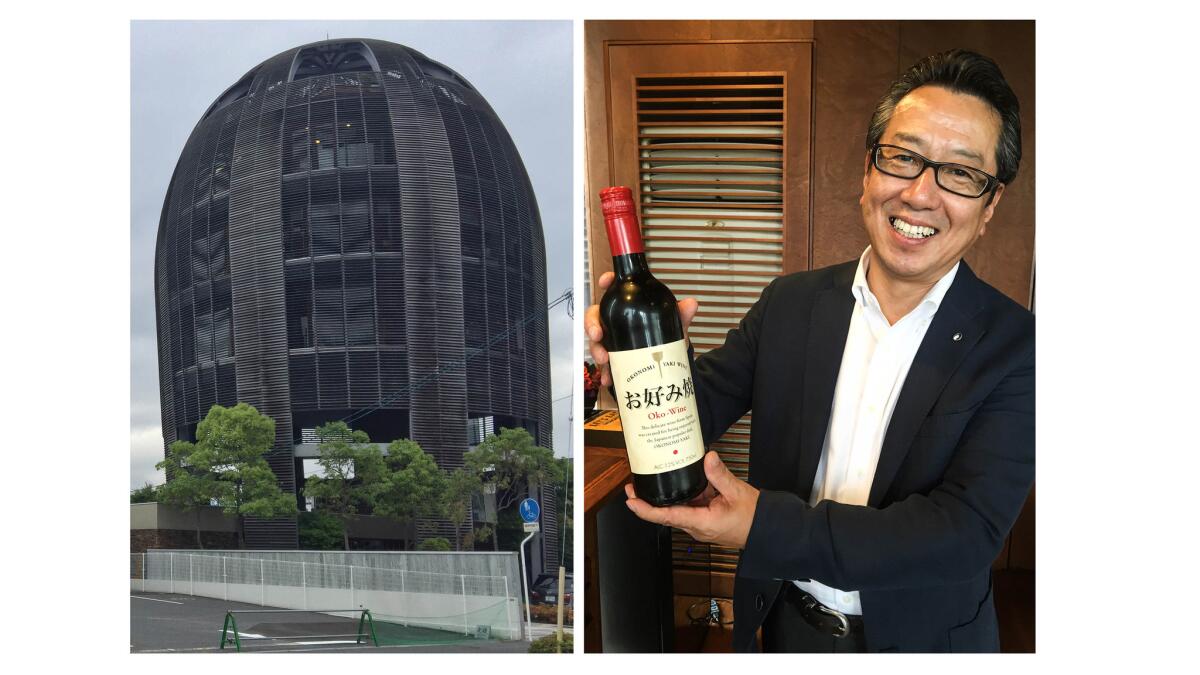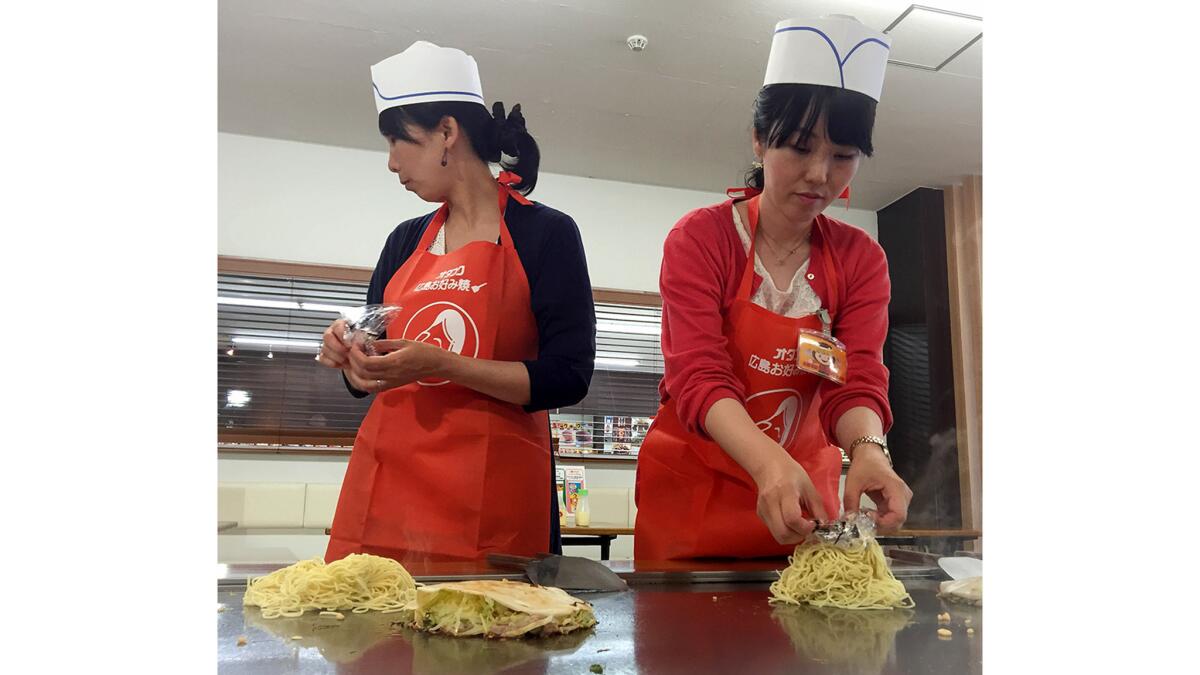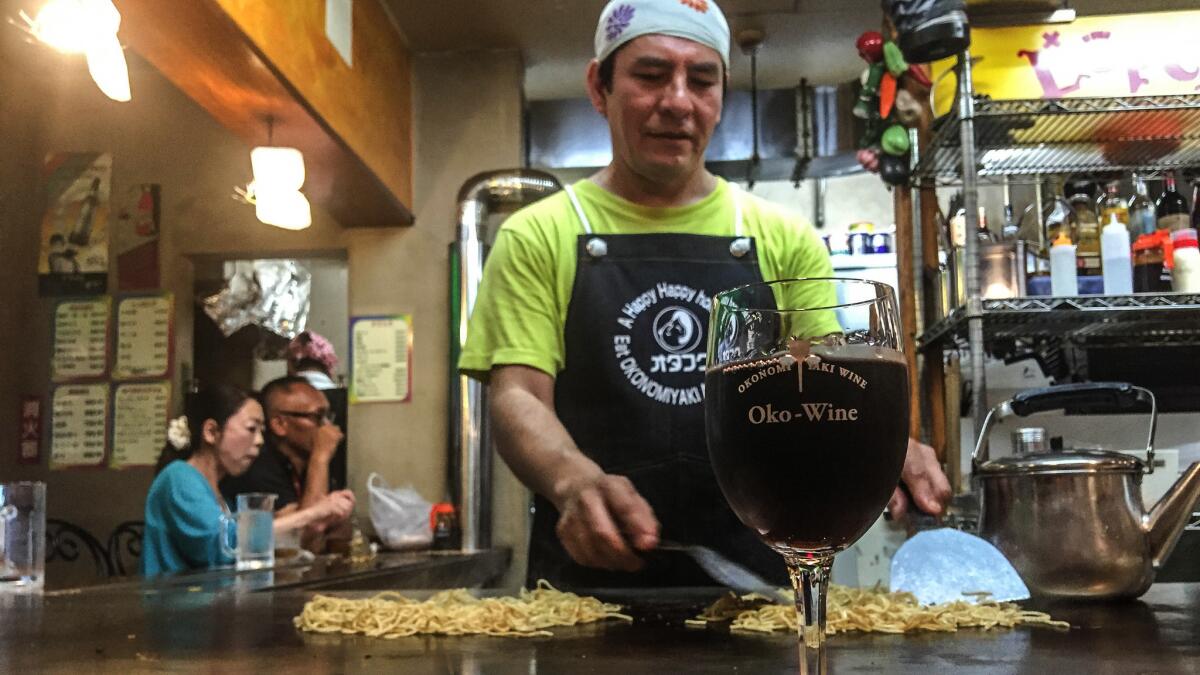War can change what we eat. Just ask Hiroshima.

- Share via
Reporting from HIROSHIMA, Japan — It’s midday on a Thursday and Yoshihiro Ueuchi is preparing to preach some culinary gospel.
He puts on a white garrison cap embroidered with his name, sound-checks his microphone headset, and picks up his hera, or spatula. Arrayed around two pool-table-size teppanyaki grills, 18 acolytes in orange aprons stand expectantly, ready to be baptized in the basics of okonomiyaki.
Szzzzzzz! The hot metal hisses as Ueuchi ladles a simple water-and-flour batter onto the surface, swirling it into a perfect disk. Next comes a heaping mound of shredded cabbage, piled up like a mini Mt. Fuji. Then green onions, bean sprouts and thick slices of pork belly.
“Temperature control is important!” advises Ueuchi, telling his disciples to pump up the heat to 300 degrees Fahrenheit from 260 degrees as he adds egg, noodles and other ingredients, then finally drenches the mass in a thick, sweet, Worcestershire-inspired sauce. The 54-year-old should know: Ueuchi estimates he’s cooked 100,000 okonomiyaki in his 30 years of working for Otafuku, the biggest okonomiyaki sauce maker in the world.

Yoshihiro Ueuchi demonstrates making an okonomiyaki.
Part omelet, part crepe, okonomiyaki (pronounced oh-ko-no-mi-yaki) is to Hiroshima what deep-dish pizza is to Chicago. Layered like a lasagna, it is as customizable as its Italian cousin and is as much a part of this Japanese port’s identity asits notoriety as the first city to be hit by a nuclear weapon.
In fact, the dropping of the bomb and the rise of okonomiyaki are intimately linked in Hiroshima.
Before the war, the savory crepes — whose lineage can be traced to Chinese pancakes known as jianbing — were sold as kids’ snacks throughout Hiroshima. Then, after 1945, war widows anxious to make ends meet started opening okonomiyaki stalls and some converted rooms in their homes into small restaurants.
They threw in whatever ingredients they could get their hands on, such as oysters and squid and soba noodles cooked by their fellow stall owners, along with ration ingredients provided by the U.S. occupiers. The elaboration was all well and good, because okonomiyaki literally means “whatever you like — grilled,” and in the lean years after the war, cheap one-dish meals were all many Hiroshimans could afford.
But even as Hiroshima started to get back on its feet in the 1950s, locals couldn’t shake their taste for okonomiyaki. Seiichi Sasaki, who opened a vinegar shop in 1922 and later got into making Worcestershire sauce, smelled an opening and began canvassing Hiroshima, asking cooks how his company could improve its products. After one chef complained that Worcestershire was too thin and always ran off his okonomiyaki, Sasaki took the idea back to his brewery and in 1952 launched his special sauce.
Nowadays, Otafuku pumps out 210,000 bottles of okonomiyaki sauce per day in Japan, along with an equal number of other bottles of condiments including mayonnaise and vinegar. In fall 2013, the company opened a factory in Los Angeles, where Otafuku produces 140,000 gallons of sauce a year for the U.S. market under the brand name OtaJoy.

But company President Naoyoshi Sasaki, grandson of Otafuku’s founder, knows that his product is more niche than, say, ketchup or mustard. If the public were to lose its taste for okonomiyaki, his empire and his 600 employees would be in jeopardy. So Otafuku, he says, must relentlessly evangelize.
“We have to expand the culture of okonomiyaki, continually,” says Sasaki. “We have to educate people about it.”
For years, Otafuku has been holding demonstrations and seminars throughout Japan at department stores and other venues, showing schoolchildren, homemakers and professional cooks how to make the dish. In 2008, it went a step further, commissioning a five-story okonomiyaki museum, shop and education center on the western side of Hiroshima, designed by architect Hiroshi Sambuichi.

The structure’s rounded form is designed to echo Hiroshima’s Atomic Bomb Dome, a landmark 1914 structure that survived the 1945 bombing. But that somber note is balanced by a lightness of form. Made of timber and vaguely shaped like an egg (a key okonomiyaki component), the building is known as the Wood Egg.
Ueuchi and others teach here, in multiple cooking studios — one for tourists, another for children and families, and a third for restaurateurs who want to open an okonomiyaki eatery or are planning to add the dish to the menu of their current establishment.
Ueuchi started working at Otafuku at age 26. He would travel around in a 2-ton truck, selling supplies to small shops and supermarkets. During that time, he says, he learned a lot about Otafuku’s product line. He learned how to make okonomiyaki and had the chance to cook at various special events.
He still cooks okonomiyaki at home about once a month — at home he has a professional-grade teppanyaki plate that is slightly less than half an inch thick. His kids like it when he cooks it. He also still orders it in restaurants.
“Each restaurant has its own taste and atmosphere, so it’s fun to try the variety,” he says.
Otafuku keeps close tabs on the number of okonomiyaki restaurants. There are more than 1,000 in Hiroshima alone, which has a population of 1.2 million, but Osaka, which has its own distinct style of okonomiyaki and has 2.7 million people, can call itself Japan’s okonomiyaki capital, with 2,850 eateries.
The statistics, though, hold some cause for concern: In 2009, there were 19,480 okonomiyaki restaurants across Japan by Otafuku’s count, but by 2014 that number had shrunk to 16,551.
Some at Otafuku suspect the drop may be related to Japan’s population decline. The rapidly graying, low-birthrate country of 127 million people lost 1 million residents between 2010 and 2015, and as older people close their mom-and-pop shops, they tend to be replaced with fewer, larger restaurants, said Akiko Tabuchi of the company’s public relations department.

Though Hiroshima is hardly starved for choices when it comes to okonomiyaki eateries, people continue to open them. Otafuku offers a three-day, $300 class for current and prospective restaurateurs. Shigenori Matsumoto, general manager of the museum at the Wood Egg, says the company encourages proprietors to find ways to make their okonomiyaki unique.
“We tell people to have a distinctive concept — like adding mushrooms if you’re in the mountains, or oysters if you’re near the sea,” says Matsumoto, who has written a book on okonomiyaki and whose business card identifies him as “okonomiyaki meister.”
One of the most well-known okonomiyaki restaurateurs in Hiroshima has done just that. Guatemala native Fernando Lopez opened his eponymous eatery in the city in 2000 after meeting his wife, a Hiroshima native, in Hawaii.

When they first moved to the city, he was thinking of opening a Southwestern American-style grill but was dissuaded by another restaurant owner who said locals wouldn’t embrace the concept. So Lopez took up okonomiyaki, adding his own flair, such as jalapeno peppers, and using double-yolk eggs.
Though okonomiyaki is still considered “soul food,” lately there’s been a trend toward upscaling, said Matsumoto, noting that one company has started selling Okonomiyaki Wine, a blend of Tempranillo, Merlot and Cabernet Sauvignon intended to be paired with the dish.
Lopez pours the Spanish vino at his counter and hands patrons a brochure touting the wine’s “round tannins with less bitterness,” which the vintners say is essential so as not to conflict with the savory umami taste of okonomiyaki.
Otafuku’s original sauce recipe has 50 ingredients, including spices, vegetables and fruits. Dates, imported from the Middle East, are an unexpected key component, Matsumoto says. But the company is constantly trying to introduce new products to keep up with modern palates — and keep okonomiyaki on plates.
It has developed a spicy variety, a lower-salt and lower-sugar option for the health conscious, and even a mild “baby” sauce suitable for kids that is gluten-free and doesn’t contain common allergens such as peanuts and crab.
“If kids become devoted to okonomiyaki when they’re young,” Matsumoto says, “we will have a customer for life.”
Follow @JulieMakLAT on Twitter for news from Asia.
ALSO
This town in South Sudan has no name. It was never supposed to exist. Now 21,000 people live there
Life in Britain’s town of Boston, known to some as the least integrated place in the country
Duterte expresses regret for his Obama insult. But he’s always had a way with words
More to Read
Sign up for Essential California
The most important California stories and recommendations in your inbox every morning.
You may occasionally receive promotional content from the Los Angeles Times.











